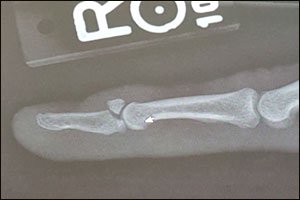BLOG: Why is this medical bill so high?
What I should have done was open my fingers a little bit more.
So, I was playing football a couple months ago with some friends. Halfway through the game a pass zipped in to me and I reached down to catch it. But I took the wrong approach on it, and the football hit me in the top of my right, middle finger. Just jammed it I figured, but after 2 weeks it was still pretty swollen and painful, so I headed to the after-hours clinic to get some x-rays. Thus began a long and interesting and educational adventure with hospital-based private practices and health insurance billing.
It turns out I fractured the distal phalange at the distal interphalangeal joint (DIP). My medical adventure went like this: one trip to after-hours clinic to see the doctor and get x-rays; three trips to the main hospital where I saw the orthopedic surgeon once (for a total of 45 seconds) and the physician’s assistant twice; two sets of x-rays there and one procedure of splinting (in a hyper-extended fashion, which is as fun as it sounds).

Rett's finger
But about 2 or 3 weeks after the first appointment, the “explanations of benefits” started to roll in to my mailbox. And that’s when my eyes were opened to the world of insurance billing for hospital-based care. After I totaled it up, the sum for all the “submitted charges” that the hospital billed my insurance during all these visits was $16,002.
Sixteen thousand dollars. That’s the amount that the hospital thought was the value of three x-rays and the x-ray technician’s time, one doctor diagnosing a fracture, another determining that splinting was the best treatment and a tech to fit me with the splint. Of course, if you have any familiarity with health insurance, you’ll know that my insurance didn’t pay the hospital $16,000. The total they paid was $3,840.88, and the total I paid was $600.48. So the hospital was reimbursed $4,441.36. After this back-and-forth predetermined dance, the hospital got a little more than a quarter of the fees it claims are reasonable and wrote off the rest.
The biggest hits were $9,596 for the orthopedic surgeon to make her diagnosis and management (for which they were actually paid $2,471) and $3,801 for “surgery” (for which they were paid $978.91). That last one made me the most upset, since I didn’t have any surgery, just splinting. And that one came with a “you owe the provider” $200 bill. I made a call into the billing inquiry line trying to correct their mistake or perhaps come to a cheaper negotiation... but no luck. I just got an explanation of “that’s just how we code for splinting,” which I knew was coming, but I wanted to voice my complaint anyway.
These fees were higher than I expected, but (besides calling splinting a surgery) not anything so far that I thought was too surprising (or blog-worthy). But deep in these bills I did find something that surprised me: Each time I went to the hospital, no matter if I only saw an ortho tech, I was charged a generic “medical care” bill for somewhere between $542 and $644. And it was this fee for which I had to pay the most from my own pocket. I dug a little deeper and found that this was a fee for the use of the hospital, something that I wouldn’t have been charged if I had gone to an orthopedic surgeon in a private practice.
And this is where I started to think about optometry. Rather than complain about how high my medical bill was, I wanted to focus on what optometry can do to grow as these specialties have. More and more specialty private practices are selling out to hospitals. The doctors can benefit from having more regular hours, fewer administrative hassles, less time on-call and the prestige of being associated with a major teaching hospital. And doctors associated with hospitals are able to charge insurances higher fees than ones who are not.
One example of how hospital-based practice is trending: in 2009 Medicare reduced its typical reimbursement to cardiologists by 30%, but it did not decrease the reimbursement to cardiologists employed by hospitals. The predictable outcome was that between 2007 and 2012, the percentage of private practice cardiologists decreased from 59% to 36%, with 31% of the remaining stating they were considering a hospital merger.
If an orthopedic surgeon’s opinion on a broken finger is worth $9,596, what’s an eye exam worth? Should we be charging more? If the reimbursement for procedures is so high, then should we be doing more procedures? And should we as a profession align more with hospitals? What are the pros and cons of that? The loss of our entrepreneurial independence at the benefit of higher reimbursement? Or should we try to fight this? Is it fair that hospitals can charge more? They do, after all, have many more responsibilities; they have to stay open 24 hours, run an emergency room and comply with many more regulations than private practices do. There is a bill in Congress to reduce the disparity between these two types of physicians, but given the vitriol about anything health care-related, it will be hard to pass.
My finger is doing much better, by the way. I’m actually very happy with my care, and I was pretty impressed with how efficient the whole thing was and how little time I spent waiting. And in the end, I think the management was good, and I’m happy with the way it healed. But the whole process left me wondering if optometry can do more. It may seem miserly to think about how we can make more money, but a proactive approach beats watching our reimbursements dwindle each year. I’d be curious to hear everyone’s thoughts.
Reference:
More cardiologists embrace working for hospitals. American Medical News. Posted Sept. 24, 2012.
